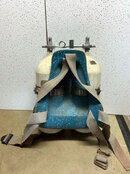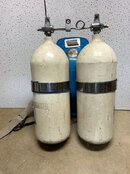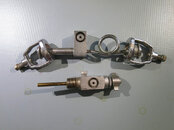I bought a batch gear off craigslist which included this doubles set. They are the first tanks I've ever seen that have NO visible markings at all, other than in the rusty patch where the paint was removed which shows two hydros:
2DM66
1"B"83, where "B" is actually a B inside a circle.
The second row on both tanks is pretty clear but for the top row I've pieced together hints from both, assuming they're the same.
They have rounded bottoms, are about 20" tall by 6 1/2" wide. I see teflon tape on the 3/4" valve threads, so I assume tapered. They both seem in remarkably good shape externally. They both held some air when I got them, and the valves work. I've since dismantled the set and opened one tank to peek inside.
I'm new to old tanks, and steel tanks, so I know next to nothing beyond what I've gleaned from old SB threads. There's a wealth of wonderful info here but it can be hard to sort it into a consistent picture. So, thanks in advance for any help and advice!
I assume there must be markings underneath the (very thick) paint, right? Is there any reason not to take a heat gun and scraper to the paint to expose the markings?
Any ideas about age/manufacturer/pressure etc. without having the markings?
Finally, have I stumbled on a set (tanks, valves, manifold, fibreglass backplate, DA Aquamaster reg with yellow hoses and mouthpiece) that should go to a good home as-is? 'cause right now I'm just thinking about the tanks.
2DM66
1"B"83, where "B" is actually a B inside a circle.
The second row on both tanks is pretty clear but for the top row I've pieced together hints from both, assuming they're the same.
They have rounded bottoms, are about 20" tall by 6 1/2" wide. I see teflon tape on the 3/4" valve threads, so I assume tapered. They both seem in remarkably good shape externally. They both held some air when I got them, and the valves work. I've since dismantled the set and opened one tank to peek inside.
I'm new to old tanks, and steel tanks, so I know next to nothing beyond what I've gleaned from old SB threads. There's a wealth of wonderful info here but it can be hard to sort it into a consistent picture. So, thanks in advance for any help and advice!
I assume there must be markings underneath the (very thick) paint, right? Is there any reason not to take a heat gun and scraper to the paint to expose the markings?
Any ideas about age/manufacturer/pressure etc. without having the markings?
Finally, have I stumbled on a set (tanks, valves, manifold, fibreglass backplate, DA Aquamaster reg with yellow hoses and mouthpiece) that should go to a good home as-is? 'cause right now I'm just thinking about the tanks.






